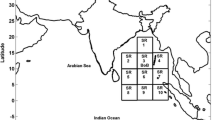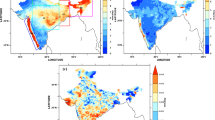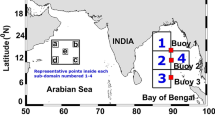Abstract
The variability of convective activity over the north Indian Ocean (Bay of Bengal and Arabian Sea) on inter-annual and longer time scales and their association with the onset, withdrawal, break and seasonal rainfall over India during the monsoon season from June to September (JJAS) has been investigated by using 40-year (1980–2019) monthly mean outgoing longwave radiation (OLR) data. The 40-year period has been divided into two groups of 20 years with the first 20 years from 1980 to 1999 (hereafter called F8099) and second 20 years from 2000 to 2019 (hereafter called L2019). It is seen that the mean sea surface temperature (SST) over the north Indian Ocean shows higher values during period L2019 compared to that in period F8099. The inter-annual variability of SST shows a significant increasing trend both over the Arabian Sea and the Bay of Bengal with a comparatively higher rate of increase of SST over the Arabian Sea. Associated with this increasing SST, the degree of moist static convective instability and associated convective rainfall is also increased during period L2019 compared to period F8099 with a magnitude of difference that is higher over the Arabian Sea compared to the Bay of Bengal. On an inter-annual scale, a significant decreasing trend of OLR anomaly (thus, an increase in convective activity) is also noticed mainly over the Arabian Sea, which is correlated with the monsoon rainfall over most of India. The analysis also indicated that there is rapid progress of monsoon to the north after its onset over the southern tip of India leading to early onset over northern India along with delayed withdrawal phase of monsoon from northwest India in period L2019 compared to period F8099 is basically due to the increasing convective activity over the north Arabian Sea and neighbourhood during the onset and withdrawal phase of monsoon, respectively. During the peak monsoon phase of July–August, convective activity over the North Bay of Bengal (NBAY) is correlated positively with the break frequency, whereas the convective activity over the North Arabian Sea (NARA), South Arabian Sea (SARA) and South Bay of Bengal (SBAY) regions are related inversely with the frequency of monsoon break.













Similar content being viewed by others
References
Boyin, H., Thorne, P. W., Banzon, V. F., Boyer, T., Chepurin, G., Lawrimore, J. H., Menne, M. J., Smith, T. M., Vose, R. S., & Zhang, H.-M. (2017). NOAA extended reconstructed sea surface temperature (ERSST), version 5. NOAA National Centers for Environmental Information. https://doi.org/10.7289/V5T72FNM
Chu, P. S., & Wang, J. B. (1997). Recent climate in the tropical western Pacific and Indian Ocean regions as detected by outgoing longwave radiation records. Journal of Climate, 10, 636–646.
Gadgil, S. (2000). Monsoon-ocean coupling. Current Science, 33, 309–323.
Gadgil, S., Vinayachandran, P. N., & Francis, P. A. (2004). Droughts of the Indian summer monsoon: role of clouds over the Indian Ocean. Current Science, 85, 1714–1719.
Hersbach, H., Bell, B., Berrisford, P., Hirahara, S., Horányi, A., Muñoz-Sabater, J., & Thépaut, J. N. (2020). The ERA5 global reanalysis. Quarterly Journal of the Royal Meteorological Society (March). https://doi.org/10.1002/qj.3803
Hoffmann, L., Günther, G., Li, D., Stein, O., Wu, X., Griessbach, S., & Wright, J. S. (2018). From ERA-Interim to ERA5: considerable impact of ECMWF’s next-generation reanalysis on Lagrangian transport simulations. Atmospheric Chemistry and Physics Discussions. https://doi.org/10.5194/acp-2018-1199
Krishnamurti, T. N., & Bhalme, H. N. (1976). Oscillations of a monsoon system. Part I. observational aspects. Journal of Atmospheric Science, 33, 1937–1954.
Krishnamurti, T. N., & Surgi, N. (1987). Observational aspects of summer monsoon. In C. P. Chang & T. N. Krishnamurti (Eds.), Monsoon meteorology (pp. 3–25). Oxford University Press.
Krishnan, R., Zhang, C., & Sugi, M. (2000). Dynamics of breaks in the Indian summer monsoon. Journal of Atmospheric Science, 57, 1354–1372.
Lau, K. M., & Chang, C. P. (1987). Planetary scale aspects of the winter monsoon and atmospheric teleconnections. In C. P. Chang & T. N. Krishnamurti (Eds.), Monsoon meteorology (pp. 161–202). Oxford University Press.
Lindzen, R. S., & Nigam, S. (1987). On the role of sea surface temperature gradients in forcing low-level winds and convergence in the tropics. Journal of Atmospheric Science, 44, 2418–2436.
Nitta, T., & Yamada, S. (1989). Recent warming of tropical sea surface temperature and its relationship to the Northern Hemisphere circulation. Journal of the Meteorological Society of Japan, 67, 375–383.
Pai, D. S., Bhate, J., Sreejith, O. P., & Hatwar, H. R. (2011). Impact of MJO on the intra-seasonal variation of summer monsoon rainfall over India. Climate Dynamics, 36, 41–55.
Pai, D. S., Sridhar, L., Rajeevan, M., Sreejith, O. P., Satbhai, N. S., & Mukhopadhyay, B. (2013). Development and Analysis of a new high spatial resolution (0.25° × 0.25°) long period (1901–2010) Daily gridded rainfall data set over India. National Climate Centre (NCC) Research Report No. 1/2013, IMD Pune, 1–72.
Pai, D. S., Arti, B., Sunitha, D., Madhuri, M., Badwaik, M. R., Kundale, A. P., Sulochana, G., Mohapatra, M., & Rajeevan, M. (2020). Normal dates of onset/progress and withdrawal of southwest monsoon over India. Mausam, 71, 553–570.
Pattanaik, D. R. (2003). Analysis of moist convective instability over Indian monsoon region and neighbourhood. Mausam, 54, 659–670.
Pattanaik, D. R. (2005). Variability of oceanic and atmospheric conditions during active and inactive periods of storm over the Indian Region. International Journal of Climatology, 25, 1523–1530.
Pattanaik, D. R. (2008). Variability of convective activity over the North Indian Ocean and its associations with Monsoon rainfall over India. Pure and Applied Geophysics, 164, 1527–1545.
Pattanaik, D., & Rajeevan, M. (2007). Northwest Pacific tropical cyclone activity and July rainfall over India. Meteorology and Atmospheric Physics, 95, 63–72. https://doi.org/10.1007/s00703-006-0193-0
Pattanaik, D. R., & Rajeevan, M. (2010). Variability of extreme rainfall events over India during southwest monsoon season. Meteorological Applications, 17(1), 88–104. https://doi.org/10.1002/met.164
Pattanaik, D. R., Kalsi, S. R., & Hatwar, H. R. (2005). Evolution of convection anomalies over the Indo–Pacific Region in relation to Indian Monsoon Rainfall. Mausam, 56, 811–824.
Pokhrel, S., & Sikka, D. R. (2013). Variability of the TRMM-PR total and convective and stratiform rain fractions over the Indian region during the summer monsoon. Climate Dynamics, 41(1), 21–44.
Rajeevan, M., De, U. S., & Prasad, R. K. (2000). Decadal variation of sea surface temperatures, cloudiness and monsoon depressions in the north Indian Ocean. Current Science, 79, 283–285.
Rajeevan, M., Bhate, J., Kale, J. D., & Lal, B. (2006). High resolution daily gridded rainfall data for the Indian region: Analysis of break and active monsoon spells. Current Science, 91(3), 296–306.
Rajeevan, M., Gadgil, S., Bhate, J. (2010). Active and break spells of the Indian Summer Monsoon. Journal of Earth System Science 119, 229–247. https://www.ias.ac.in/article/fulltext/jess/119/03/0229-0247.
Ramaswamy, C. (1962). Breaks in the Indian summer monsoon as a phenomenon of interaction between the easterly and the sub-tropical westerly jet streams. Tellus, XIV, 3, 337–349. https://doi.org/10.1111/j.2153-3490.1962.tb01346.x
Roxy, M. K., Ritika, K., Terray, P., & Masson, S. (2014). The curious case of Indian Ocean warming. Journal of Climate, 27, 8501–8509.
Sikka, D. R., & Sulochana, G. (1980). On the maximum cloud zone and the ITCZ over Indian, longitudes during the southwest monsoon. Monthly Weather Review, 108(11), 1840–1853. ISSN 0027-0644.
Sperber, K. R., & Palmer, T. N. (1996). Interannual tropical rainfall variability in general circulation model intercomparison project. Journal of Climate, 9, 2727–2750.
Wang, B. (1995). Interdecadal changes in El Nino onset in the last four decades. Journal of Climate, 8, 267–285.
Webster, P. J., Magana, V. O., Palmer, T. N., Shukla, J., Tomas, R. A., Yanai, M., & Yasunari, T. (1998). Monsoons, processes, predictability, and the prospects for prediction. Journal of Geophysical Research., 103, 14451–14510.
Wheeler, M., & Hendon, H. (2004). An all-season real-time multivariate MJO index: development of an index for monitoring and prediction. Monthly Weather Review., 132, 1917–1932.
Acknowledgements
The author is very much thankful to Dr. M. Mohapatra, the Director General, India Meteorological Department, New Delhi, for encouragement and for providing all facilities to carry out this research work. Thanks are due to NOAA for providing OLR and SST data used in this study. We are also thankful to ECMWF for making available the ERA5 reanalysis data for the convective rainfall. Thanks are also due to my colleagues from NWP division, IMD New Delhi and CRS, IMD Pune for their support.
Author information
Authors and Affiliations
Corresponding author
Additional information
Publisher's Note
Springer Nature remains neutral with regard to jurisdictional claims in published maps and institutional affiliations.
Rights and permissions
About this article
Cite this article
Pattanaik, D.R. Changes in Convective Activity Over the Indian Ocean and Neighbourhood in Relation to Onset, Withdrawal and Break Features of Monsoon. Pure Appl. Geophys. 178, 3703–3726 (2021). https://doi.org/10.1007/s00024-021-02846-4
Received:
Revised:
Accepted:
Published:
Issue Date:
DOI: https://doi.org/10.1007/s00024-021-02846-4




